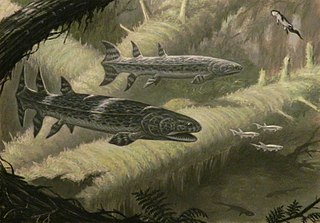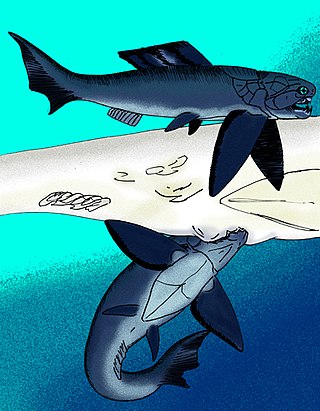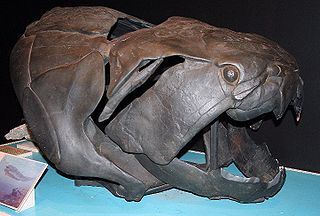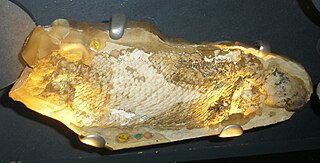
The Carboniferous is a geologic period and system of the Paleozoic era that spans 60 million years from the end of the Devonian Period 358.9 Ma to the beginning of the Permian Period, 298.9 Ma. It is the fifth and penultimate period of the Paleozoic era and the fifth period of the Phanerozoic eon. In North America, the Carboniferous is often treated as two separate geological periods, the earlier Mississippian and the later Pennsylvanian.

The Devonian is a geologic period and system of the Paleozoic era during the Phanerozoic eon, spanning 60.3 million years from the end of the preceding Silurian period at 419.2 million years ago (Ma), to the beginning of the succeeding Carboniferous period at 358.9 Ma. It is the fourth period of both the Paleozoic and the Phanerozoic. It is named after Devon, South West England, where rocks from this period were first studied.

The lycophytes, when broadly circumscribed, are a group of vascular plants that include the clubmosses. They are sometimes placed in a division Lycopodiophyta or Lycophyta or in a subdivision Lycopodiophytina. They are one of the oldest lineages of extant (living) vascular plants; the group contains extinct plants that have been dated from the Silurian. Lycophytes were some of the dominating plant species of the Carboniferous period, and included the tree-like Lepidodendrales, some of which grew over 40 metres (130 ft) in height, although extant lycophytes are relatively small plants.

Dunkleosteus is an extinct genus of large arthrodire ("jointed-neck") fish that existed during the Late Devonian period, about 382–358 million years ago. It was a pelagic fish inhabiting open waters, and one of the first apex predators of any ecosystem.

Eusthenopteron is a genus of prehistoric sarcopterygian fish known from several species that lived during the Late Devonian period, about 385 million years ago. It has attained an iconic status from its close relationship to tetrapods. Early depictions of animals of this genus show them emerging onto land, but paleontologists now think that eusthenopteron species were strictly aquatic animals, though this is not completely known.
The Famennian is the later of two faunal stages in the Late Devonian epoch. The most recent estimate for its duration is that it lasted from around 371.1 to 359.3 million years ago. An earlier 2012 estimate, still used by the International Commission on Stratigraphy, is that it lasted from 372.2 million years ago to 358.9 million years ago. It was preceded by the Frasnian stage and followed by the Tournaisian stage.

Hyneria is a genus of large prehistoric predatory lobe-finned fish which lived in fresh water during the Famennian stage of the Devonian period.

Dinichthys is an extinct monospecific genus of large marine arthrodire placoderm from the Late Devonian measuring around 3 metres (9.8 ft) long. Fossils were recovered from the Ohio Shale Formation along the Olentangy River in Delaware County, Ohio.

Dunkleosteidae is an extinct family of arthrodire placoderms that lived during the Devonian period. The gigantic apex predator Dunkleosteus terrelli is the best known member of this group.
Tornoceratidae is a family of goniatitid ammonoids from the middle and upper Devonian. The family is included in the suborder Tornoceratina and the superfamily Tornoceratoidea.

Monograptus is a genus of graptolites in the order Graptoloidea. This particular genus is the last stage of the graptoloid evolution before its extinction in the early Devonian. A characteristic of the genus includes one uniserial stipes with very elaborate thecae. This particular genus contains large number of graptolite species and may not be monophyletic.

Adelophthalmus is a genus of eurypterid, an extinct group of aquatic arthropods. Fossils of Adelophthalmus have been discovered in deposits ranging in age from the Early Devonian to the Early Permian, which makes it the longest lived of all known eurypterid genera, with a total temporal range of over 120 million years. Adelopththalmus was the final genus of the Eurypterina suborder of eurypterids and consisted the only known genus of swimming eurypterids from the Middle Devonian until its extinction during the Permian, after which the few surviving eurypterids were all walking forms of the suborder Stylonurina.

Phyllolepis is the type genus of Phyllolepida, an extinct taxon of arthrodire placoderm fish from the middle to late Devonian. The species of Phyllolepis, themselves, are restricted to the Famennian-aged freshwater strata of the Late Devonian, around 360 million years ago. Fossils of this genus have been found primarily in Europe and North America. The end of the Devonian saw them disappear in a mass extinction.

Chirodipterus is an extinct genus of marine lungfish which lived during the Devonian period. Fossils have been found worldwide, including Germany, China, eastern & western Australia, and the United States (Michigan). However, it has been suggested that the genus as currently defined is polyphyletic, in which case only the German type species would belong to the genus.

Laccognathus is an extinct genus of amphibious lobe-finned fish from Europe and North America. They existed from the Middle Devonian to the Late Devonian. The name comes from Greek for 'pitted jaw'.

Adoketophyton is a genus of extinct vascular plants of the Early Devonian. The plant was first described in 1977 based on fossil specimens from the Posongchong Formation, Wenshan district, Yunnan, China. These were originally named Zosterophyllum subverticillatum; later the species was transferred to a new genus as Adoketophyton subverticillatum. One cladistic analysis suggested that it is a lycophyte, related to the zosterophylls. Other researchers regard its placement within the vascular plants as uncertain.
Falcitornoceras is a goniatitid ammonite from the Late Devonian, early Famennian, that has been found in France and Spain. Falcitornoceras was named by House and Price, 1985, and is the type genus for the subfamily Falcitornoceratinae.
Gundolficeras is member of the Tornoceratidae,, from the Late Devonian named by Becker, 1995 and assigned to the Falcitornoceratinae. The type species is "Lobotornoceras" bicaniculatum.
Kourazouceras is an extinct ammonoid genus from the Late Devonian assigned to the tornoceratid subfamily Falcitornoceratinae. As such it is related to Falcitornoceras, Gundolficeras, and Phoenixites.
Palmatolepis is an extinct conodont genus in the family Palmatolepidae. It was the most abundant genus of conodonts of the Late Devonian, disappearing during the Devonian/Carboniferous crisis.













